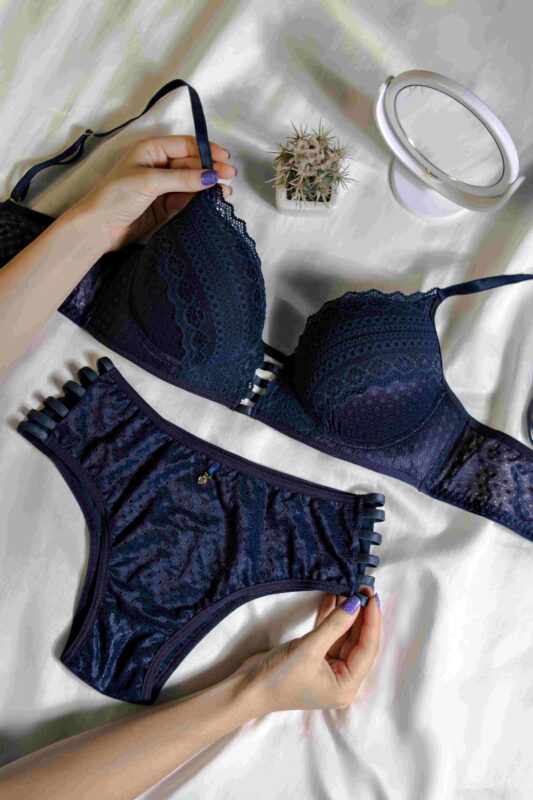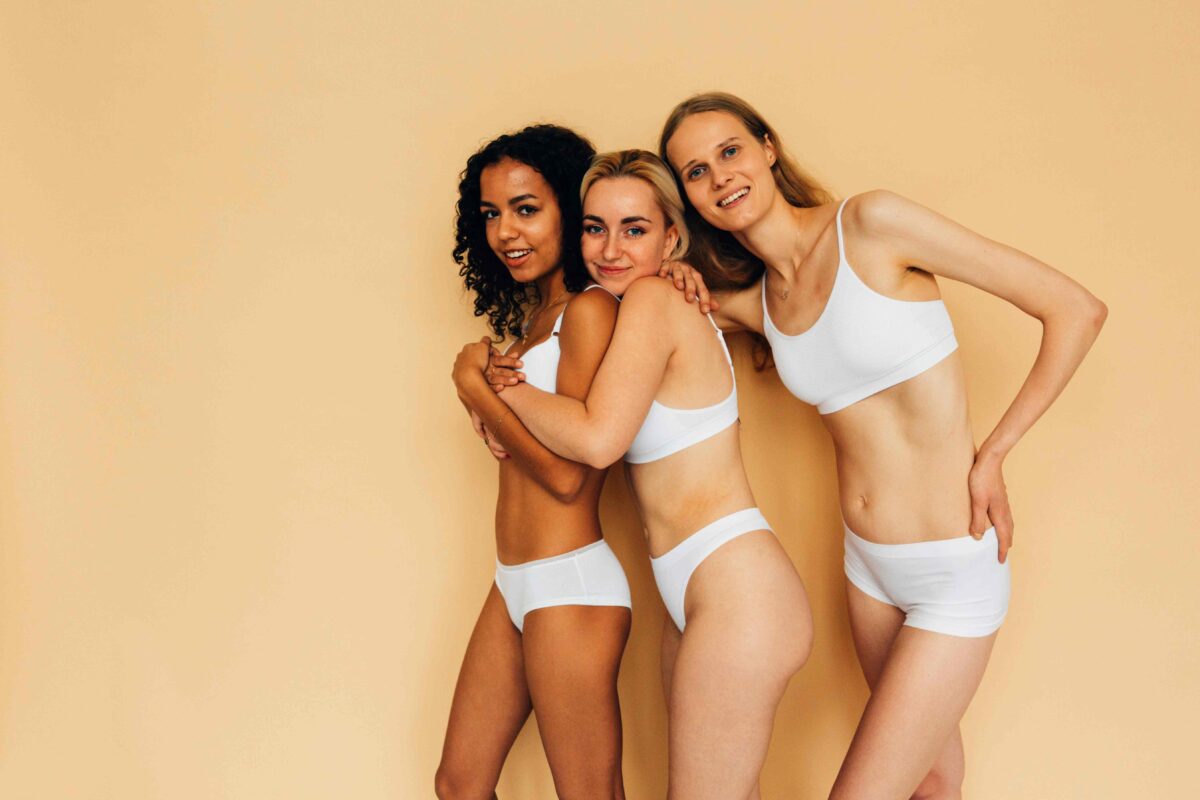Privátní značení, které je stále populárnější v celém oděvním odvětví, umožňuje distributorům a prodejcům profitovat z rostoucí poptávky zákazníků po osobitých, prémiových výrobcích. Vlastní spodní prádlo je jedním z produktů, který tuto možnost skutečně využívá. Intimní oblečení, které je poháněno jak základními požadavky, tak dychtivostí spotřebitelů utrácet za příjemné a módní spodní prádlo, zůstává evergreenem trhu. Vaše společnost může vyniknout vzory, látkami a značkou, které osloví cílové trhy, a to od těch, kteří vyhledávají každodenní pohodlí, až po sportovce a spotřebitele, kteří dbají na trendy, a to zavedením privátní značky zahrnující spodní prádlo na zakázku.

Vytvoření prosperující privátní značky však vyžaduje mnohem více než jen navrhnout logo na sériově vyráběné zboží. Skutečný úspěch je výsledkem rozsáhlého průzkumu trhu, strategického designu, pečlivého plánování výroby, kontroly nákladů a chytrých marketingových kampaní. Musíte se zaměřit na výběr zdrojů, zaručit stálou kvalitu výroby a přizpůsobit distribuční logistiku. Pro podniky orientované na B2B - distributory, velkoobchodníky nebo prodejce - se obtížnost ještě zhoršuje kvůli obrovským objemům a požadovaným standardům kvality. V této příručce se budeme zabývat klíčovými kroky pro zahájení výroby vlastní značky spodního prádla na zakázku, která zvýší vaše příjmy, potěší vaše zákazníky a připraví vaši společnost na dlouhodobý růst. Ať už jste začátečník, který hledá úspěšný výklenek, nebo zkušený distributor připravený diverzifikovat svou činnost, přečtěte si plán na cestu k úspěchu privátní značky.
Vyhledávání příležitostí na trhu se spodním prádlem na zakázku
Než začnete navrhovat nebo si zajistíte výrobní partnery, ujistěte se, že pro vaše spodní prádlo na míru existuje skutečný trh. Vyhledání nedostatečně obsazených trhů nebo nových trendů zaručí, že vaše privátní značka bude jedinečná a přitáhne opakované zakázky.
Zjišťování demografických údajů spotřebitelů
Koho byste rádi viděli ve své řadě spodního prádla? Muži, kteří hledají výkonné spodní prádlo pro sport, dámy, které hledají prodyšné a stylové intimní oblečení, a unisex nebo genderově neutrální volby, které odpovídají různým identitám, to vše spadá do trhu s intimním oblečením. Každá skupina přikládá nejvyšší důležitost jiným faktorům: textiliím odvádějícím vlhkost, pohodlným pasům, malému počtu švů nebo výrazným vzorům. Začněte zkoumat nejprve kategorie s největším růstem nebo ty, u nichž je zřejmý nedostatek rozmanitosti a kvalitativních standardů.
Sledování inovací tkanin
Materiály použité u spodního prádla na zakázku často určují jeho kvalitu. Zákazníci si stále častěji vybírají látky, které zlepšují pohodlí a výkon, včetně organické bavlny, směsí bambusové viskózy, textilií s příměsí spandexu pro větší pružnost. Někteří lidé mají rádi vysoce pokročilé tkaniny, které mají regulovat teplotu, odvádět pot nebo omezovat zápach. Zkoumání těchto trendů v oblasti tkanin umožní vaší společnosti oslovit specifické zákazníky, včetně profesionálů, kteří hledají celodenní pohodlí, sportovců, ekologicky smýšlejících spotřebitelů nebo dalších.
Studium konkurentů
Zkoumání současných značek spodního prádla pod vlastní značkou odhaluje běžné chyby a úspěchy. Pokud zjistíte, že jiní B2B distributoři nejsou schopni uspokojit poptávku po spodním prádle plus size nebo vyrábějí pouze standardní střihy s omezeným počtem vzorů, můžete svou řadu upravit tak, abyste tyto nedostatky napravili. Zkoumání konkurenčního terénu vám pomůže zlepšit vlastní prodejní nabídku tím, že se zaměříte na vlastnosti, jako je inkluzivita, kvalita zpracování nebo specializované textilie, které ostatní přehlížejí.
Využití sezónních trendů a trendů životního stylu
Vzorce nákupu spodního prádla se mohou měnit v době svátků (Valentýn) nebo v době sportovních sezón u sportovního oblečení. Sledování těchto špiček vám pomůže vytvořit cílené marketingové plány a odhadnout poptávku po zásobách. Dále berte v úvahu rostoucí trend práce na dálku: pokud člověk tráví více času doma, mohou profesionálové dávat přednost pohodlnému, ale módnímu spodnímu prádlu. Tyto mikrotrendy ovlivňují rozhodnutí o designu a pomáhají vašemu podniku najít úspěšné niky.
Navrhování vlastního spodního prádla, které odráží identitu vaší privátní značky
Jakmile ověříte poptávku na trhu, je čas vytvořit identitu vaší nabídky spodního prádla na zakázku. Dlouhodobý úspěch je dán uceleným přístupem k designu, který zároveň zvyšuje atraktivitu značky.
Sladění s hodnotami a estetikou značky
Vynikající identifikace značky vytváří u spotřebitelů emocionální vazby. Pokud vaše značka klade důraz na udržitelnost, propagujte ekologická barviva a textil získaný etickým způsobem. Pokud je na prvním místě výkon, zdůrazněte prvky, jako jsou síťované panely pro prodyšnost a ergonomické švy pro minimalizaci otlaků. Jasné vymezení základních myšlenek vaší značky zaručí, že každý design - od střihu oblečení až po obal - bude odrážet vaši celkovou vizi.
Náčrt střihů, pasů a stehů
Design spodního prádla přesahuje barvy a umístění značky. Zapomenutelný prvek v pase (elastický druh, integrace značky), poloha švů (flatlock vs. overlock), rozepínání nohaviček (boxerky vs. trenýrky vs. slipy) a struktura panelů mohou mít zásadní vliv. Spolupracujte s nadanými návrháři, kteří mají zkušenosti s intimním oblečením, nebo investujte do znalostí tvorby vzorů, abyste zaručili správnou velikost a pohodlí pro různé typy postav.
Začlenění vizuální identity
Vaše logo, barevné schéma a písmo by měly být přítomny, ale tlumeně. Zvláště nápadné nebo příliš velké značky mohou odradit některé spotřebitele, kteří mají rádi tlumené označení. Na druhou stranu zákazníci, kteří si značku uvědomují, by mohli uvítat zvýraznění identifikovatelného loga v pase. Najděte kombinaci, která bude vyhovovat vašemu zamýšlenému trhu. Pokud je individualita vaší značky silná, zařaďte výrazné barevné bloky nebo výrazné potisky. Pokud je vaším cílem minimalismus, soustřeďte se na tónované nebo tlumené výšivky.
Odběr vzorků a uživatelské testování
Vytvářejte prototypy v mnoha střizích, velikostech a barevných provedeních. Sdílejte zkušební vzorky mezi spolehlivými spolupracovníky nebo možnými klienty a získejte komentáře k jejich střihu, pohodlí a stylu. Vyhrnuje se pásek dolů nebo tlačí? Je materiál pro celodenní nošení dostatečně měkký? Tato odhalení vám pomohou vylepšit vzory, změnit umístění značky nebo zvolit jiné materiály. Tato strategie řízená uživateli pomáhá snížit počet později nákladných výrobních chyb.
Navrhování spodního prádla, které kombinuje identifikaci značky s užitečnými prvky, vytváří emocionální spojení se spotřebiteli a pomáhá jim propagovat vaši značku. Dobře provedené návrhy mohou z prvních spotřebitelů udělat šampiony, a tím podpořit přirozené rozšíření vaší privátní značky ve velkoobchodní a distribuční sféře.
Získávání a spolupráce se spolehlivými výrobci spodního prádla na zakázku
Bez spolehlivého výrobního partnera mohou být i ty nejlepší designové nápady neúspěšné. Spodní prádlo na zakázku, které uspokojí B2B spotřebitele, závisí především na efektivních výrobních cyklech, stálé kvalitě a férové ceně.
Definování požadavků na výrobu
Než začnete kontaktovat možné dodavatele, upřesněte si výrobní limity:
Větší objednávky často přinášejí úspory, ale vyžadují větší počáteční investici do MOQ neboli minimálního objednacího množství.
Sdílejte specifikace tkanin, jako jsou směsi bavlny a lycry nebo modalu, a preferované postupy úpravy tkanin a materiálů.
Jasně definujte rozsah možností personalizace - od potištěných pásů až po vyšívaná loga nebo štítky přenášené teplem.
Leader Times: Srovnejte svůj marketingový kalendář s výrobním kalendářem. Spouštíte novou linku před sezónní špičkou? Ověřte si, zda výroba dokáže dodržet termíny.
Prověřování pověření továrny
Ne každý výrobce oděvů je stejně vhodný pro tvorbu personalizovaného spodního prádla. Vzhledem k tomu, že obvykle znají umístění švů, napětí gumy a tělesné pohodlí dokonaleji, je třeba navštívit zařízení specializovaná na intimní oděvy. Projděte si jejich certifikace - například shodu s ISO, WRAP pro etickou výrobu - a poté se podívejte na nabídky klientů a vyžádejte si reference. Pokud je to možné, naplánujte si virtuální prohlídku továrny nebo návštěvu na místě, abyste se přímo seznámili s metodami kontroly kvality.
Vyjednávání o spravedlivé ceně
Očekávejte, že ceny se budou lišit v závislosti na:
- Typ tkaniny: Ekologické nebo speciální materiály jsou obvykle dražší než standardní bavlna.
- Složitost návrhu: Více barevných panelů nebo složitá loga zvyšují výrobní náklady.
- Objem objednávky: Vyšší objem často znamená nižší náklady na jednotku.
- Přeprava: Do konečných nákladů se započítává mezinárodní a vnitrostátní přeprava a případné celní poplatky.
Vyjednejte výdaje a pak se soustřeďte na vytvoření dlouhodobého spojenectví namísto určování nejnižší ceny. Pro oddané zákazníky by spolehliví výrobci mohli poskytnout rychlejší obraty, lepší asistenci nebo flexibilní platební podmínky.
Zajištění konzistentní kvality
Jasně definujte svůj systém kontroly kvality. Zjistěte si u výrobce, jakým způsobem provádí kontroly - zda používá standardizované testování odolnosti tkaniny, závěrečné namátkové kontroly, nebo kontroly na lince? Ověřte si, zda se shodují dohodnuté postupy přepracování, normy balení a přijatelná míra vad. Kromě toho, že špatně zkonstruované prádlo snižuje hodnotu značky, způsobuje drahé vrácení zboží nebo nespokojenost obchodů a konečných spotřebitelů.
Spolupráce s renomovaným výrobcem, který zná jemnosti intimního oblečení, pomůže vaší privátní značce získat stálou kvalitu a lepší výrobní cykly. Díky této spolupráci se vaši zaměstnanci mohou soustředit na prodej, marketing a zkoumání dalších výrobků.

Stanovení ceny a umístění vlastní značky spodního prádla
Stanovení ceny je jedním z nejcitlivějších aspektů zavedení jakékoli privátní značky; jedná se o strategický krok, který může výrazně ovlivnit ziskovost a pověst značky. V případě vlastního spodního prádla to znamená uznání na trhu, přiměřený zisk a konzistentní soulad sdělení s vaší značkou.
Provedení analýzy konkurence
Chcete-li zvolit cenové rozpětí, prozkoumejte příbuzné řady spodního prádla soukromých značek na vašem trhu. Pokud vaše značka klade důraz na ekologické materiály a luxusní pohodlí, můžete pravděpodobně obhájit dražší ceny, než je standard masového trhu. Musíte se však ujistit, že spotřebitelé - stejně jako obchody nebo distributoři, kteří od vás nakupují - vidí ve vyšších cenách skutečnou hodnotu.
Zohlednění maržových požadavků
Obecně platí, že transakce B2B mají jinou strukturu přirážek než modely přímé komunikace se spotřebitelem. Vaši velkoobchodní partneři chtějí dostatečně velkou slevu, která jim umožní přidat vlastní marži. Abyste těmto vrstvám vytvořili prostor:
- Výpočet výrobních nákladů: Shrňte látku, ozdoby, práci, dopravu a režijní náklady.
- Přidat značku: Usilujte o ziskové rozpětí, které vám zajistí výdělek.
- Nechte prostor distributorům: Pro maloobchodní prodej budou opět zdražovat. Vyváží konečnou maloobchodní cenu tak, aby zůstala konkurenceschopná.
Strategie umístění
Pozice vaší značky ovlivní, jak budou prodejci nebo online tržiště vnímat vaše vlastní spodní prádlo. Mezi možnosti patří:
- Segment Premium: Pokud používáte ekologické a etické materiály a pokročilé stavební techniky, zdůrazněte tyto vlastnosti. Váš marketing by se měl zaměřit na řemeslné zpracování a exkluzivitu.
- Cenově výhodná výklenek: Vycházejte vstříc zákazníkům, kteří si uvědomují svůj rozpočet, a klaďte důraz na trvanlivost, pohodlí a cenovou dostupnost.
- Zaměření na životní styl: Spojte své spodní prádlo se specifickými životními styly - sportovci, milovníky jógy nebo zaneprázdněnými profesionály. Přizpůsobte příběh své značky a obal tak, aby s těmito segmenty rezonoval.
Sdělování hodnoty kupujícím
Zákazníci ve vztazích mezi podniky, zejména velkoobchodníci a distributoři, oceňují otevřenou politiku nákladů a cen. Chcete-li podpořit navrhovanou maloobchodní cenu, ukažte rozdělení nebo zdůrazněte speciální prodejní vlastnosti, jako je technologie odvádějící pot nebo přizpůsobené pasy. Je pravděpodobnější, že budou nakupovat z vaší řady, pokud rozpoznají výjimečnou kvalitu značky a najdou důkaz o poptávce spotřebitelů.
Pečlivé vyvážení struktury nákladů a vnímané hodnoty může obchodům pomoci dosáhnout zisku, zatímco koncoví uživatelé se budou cítit oprávněně, a podpoří tak trvalou poptávku po vaší privátní značce. Správné držení těla pomáhá vaší značce zviditelnit se na trhu, a proto je vaše vlastní spodní prádlo skvělou volbou pro různé typy zákazníků.
Marketing a růst značky vlastního spodního prádla pod vlastní značkou
I to nejkvalitnější spodní prádlo potřebuje silný marketing, aby mohlo prosperovat. Marketingové strategie zaměřené na B2B spotřebitele, jako jsou kamenné obchody, internetové obchody nebo distributoři oblečení, musí zdůrazňovat nejen styl a pohodlí, ale také prodejní potenciál a dlouhodobou spolehlivost.
Budování online prezentace
Profesionální webové stránky nebo speciální vstupní stránka prezentující vaše spodní prádlo na zakázku jsou nezbytné. Zahrnuje:
- Vysoce kvalitní fotografie produktů: Investujte do vizuálního vyprávění, které zachycuje detaily látek, varianty střihů a barevné varianty.
- Technické popisy: Uveďte specifikace, jako je složení tkaniny, velikostní tabulky a jedinečné komfortní vlastnosti.
- Velkoobchodní dotazy: Usnadněte potenciálním distributorům kontakt s vámi. Výrazně zobrazte tlačítko "Vyžádat si hromadné ceny" nebo "Kontaktovat pro velkoobchod".
Přidejte profily na sociálních sítích LinkedIn (pro navázání kontaktů s profesionály v oblasti B2B), Instagram (pro zobrazení obrázků produktů) a možná TikHub (pokud vaše značka oslovuje mladší zákazníky, kteří hledají moderní trendy v odívání).
Představení úspěšných maloobchodních příběhů
Případové studie nebo citace dokazující, jak maloobchodní partner nebo prodejce zvýšil své příjmy díky vašemu personalizovanému spodnímu prádlu, mohou inspirovat nové obchody. Sdílejte úspěšné příběhy o přínosech synergie se značkou, zpětné vazbě od zákazníků nebo zvýšení prodeje. Tato strategie staví vaši privátní značku spíše do pozice osvědčené sázky než nebezpečného nováčka.
Využití veletrhů a akcí
Obchodní akce zaměřené na průmyslové expozice nebo oděvy poskytují vynikající příležitosti pro představení nových řad, navázání kontaktů s možnými partnery a analýzu trendů. Uspořádejte vizuálně poutavou expozici, která návštěvníkům umožní osahat si a prohlédnout si vzorky zboží. Připravte si přehledy sortimentu, letáky a vizitky, abyste mohli případné partnery rychle kontaktovat. Veletrhy nabízejí také příležitosti k navázání užitečných partnerství nebo sponzorství.
Digitální oslovení a e-mailový marketing
Přestože expozice závisí na sociálních médiích, e-mailový marketing je stále mocným nástrojem pro přímou obchodní komunikaci. Vytvořte si seznam možných prodejců, distributorů a dalších vedoucích pracovníků. Pravidelně rozesílejte maily zdůrazňující nové výrobky, speciální nabídky nebo prohlídky zákulisí vašeho výrobního závodu. Věnujte velkou pozornost tomu, jak by vaše řada mohla uspokojit měnící se vkus spotřebitelů nebo pokrýt nedostatek zásob.
Spolupráce s influencery nebo ambasadory
Někdy zákazníci B2B věnují velkou pozornost spotřebitelskému rozruchu kolem značky. Získání potvrzení od mikroinfluencerů z niky životního stylu, cestování nebo fitness vám pomůže legitimizovat vaše personalizované spodní prádlo pro koncové spotřebitele, a tím umožní obchodníkům snadněji vnímat poptávku. Ačkoli je obvyklý marketing s influencery určen spotřebitelům, zvýšená znalost značky může nepřímo pomoci vaší B2B atraktivitě.
Pomocí rozmanité marketingové strategie zvyšujete povědomí a budujete si dobré jméno. Prezentace konzistentního příběhu značky podpořeného vynikajícími položkami, profesionálními obrázky a reálnými referencemi pomáhá distributorům a obchodům snadněji investovat do vaší privátní značky. Tyto marketingové iniciativy na sebe časem navazují a pomohou vám etablovat se jako preferovaný zdroj vlastního spodního prádla v oblasti business-to-business.
Závěr
Vytvoření silné privátní značky spodního prádla na zakázku je zajímavý, ale obtížný projekt. Váš úspěch jako B2B distributora nebo prodejce závisí na jiných faktorech než jen na vzhledu nebo konkurenceschopné ceně. Počínaje znalostí preferencí zákazníků a potřeb trhu - od pokroků v oblasti tkanin až po nové nápady - cesta pokračuje strategickými rozhodnutími o designu, která obratně kombinují identitu značky. Zatímco dobře kalibrovaná cenotvorba a umístění značky potvrzují vítězný vzorec pro dlouhodobou ziskovost, důvěryhodné vztahy s odborníky na výrobu zaručují kvalitu výrobků.
Neméně důležitá je vaše schopnost správně propagovat vaši privátní značku. Silné informační kanály B2B, zajímavé příběhy značky a působivé obrázky vám pomohou vybudovat vztahy s vhodnými partnery. Na přeplněném trhu odlišíte svou nabídku zdůrazněním udržitelnosti, kreativity nebo specializované přitažlivosti. Výhody jdou nad rámec dočasného prodeje: dobře vyrobená řada spodního prádla se může vyvinout ve známou, vyhledávanou značku, která produkuje stálé objednávky a podporuje rozvoj do dalších oděvních odvětví.
Založení lukrativní privátní značky na trhu s intimním oblečením v podstatě vyžaduje promyšlenost, odhodlání a schopnost spolupráce na základě znalostí. Se správnou cestovní mapou zahrnující design, zásobování, cenu a marketingovou strategii můžete směle vyrábět spodní prádlo na zakázku uspokojující velkoobjemové potřeby B2B a zároveň potěšit koncové spotřebitele. Pokud jste připraveni skočit a formovat budoucnost svého podnikání, použijte tyto pokyny, abyste vynikli, maximalizovali zisky a vybudovali si celoživotní vztahy v oboru.
Nejčastější dotazy
- Jak najít správného výrobce pro výrobu spodního prádla na zakázku?
Vyhledejte výrobce intimního oblečení a zkontrolujte jejich pověření - například etické výrobní normy nebo certifikace ISO. Chcete-li posoudit jejich kvalitu, vyžádejte si vzorky; také se zamyslete nad spoluprací s dodavatelem, který má za sebou historii včasného dodání objednávek. Důležité je také vyjednávání o rozumných podmínkách a udržování otevřených kontaktů po celou dobu procesu.
- Jaké jsou nejoblíbenější materiály pro spodní prádlo na zakázku?
Mezi běžné tkaniny se zvýšenou elasticitou patří směsi bavlny, bambusové viskózy, modalu a textilií obsahujících spandex. Pokud jde o trvanlivost, pohodlí a prodyšnost, má každý druh tkaniny zvláštní výhody. Vaše rozhodnutí bude záviset na cílovém trhu: každodenní uživatelé mohou dávat přednost měkkosti a snadné údržbě, zatímco aktivní uživatelé mohou chtít výkonné směsi.
- Mohu v rámci jedné privátní značky nabízet pánské i dámské spodní prádlo na zakázku?
Ano, i když každá řada bude mít jiné konstrukční problémy. Pánské střihy často zdůrazňují podporu a užitkovost (boxerky, trenýrky, slipy), zatímco dámské volby mohou sahat od chlapeckých šortek až po bikiny a hipstery. Dbejte na to, aby obě linie měly srovnatelné aspekty značky, ale přizpůsobte je tak, aby odpovídaly různým estetickým standardům a preferencím střihu každého publika.
- Jak mohu snížit výrobní náklady, aniž by byla ohrožena kvalita?
Větší objem objednávek někdy snižuje náklady na jednotku. Chcete-li omezit plýtvání látkami, zvolit přizpůsobivé odstíny, které osloví více zákazníků, a vyjednat dobré přepravní podmínky, můžete také zjednodušit vzory. U materiálů nebo zpracování se však vyhněte úsporám, protože nekvalitní výrobky by mohly poškodit pověst vaší značky a vést k většímu počtu vrácených výrobků nebo reklamací.
- Jaké marketingové kanály nejlépe fungují pro propagaci značky vlastního spodního prádla u B2B zákazníků?
U B2B kupujících často rezonuje specializovaná produktová expozice na vašich webových stránkách v kombinaci s LinkedIn pro profesionální networking. Šanci prezentovat své produkty a navázat přímé vztahy představují také veletrhy, oborové konference a cílené e-mailové kampaně. Zdůrazněte výhody produktů, ukažte působivé obrázky a vysvětlete, jak by vaše řada mohla zaplnit mezeru v jejich atraktivitě pro koncové uživatele nebo v sortimentu.
Vylepšete svou privátní značku spodním prádlem na zakázku, které v sobě spojuje pohodlí, kvalitu a módní vzory. Na Modenly, specializujeme se na vedení klientů B2B - pomáháme vám získat špičkové materiály, zdokonalit identitu vaší značky a zefektivnit výrobu od konceptu až po dodání.

